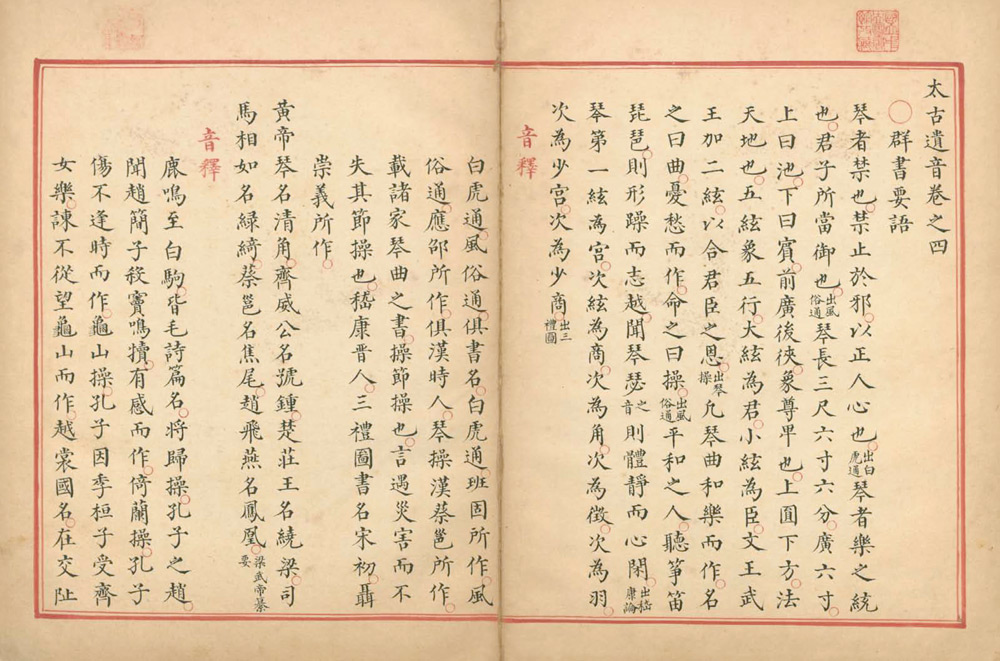|
T of C
Home |
My Work |
Hand- books |
Qin as Object |
Qin in Art |
Poetry / Song |
Hear, Watch |
Play Qin |
Analysis | History |
Ideo- logy |
Miscel- lanea |
More Info |
Personal | email me search me |
| Taiyin Daquanji ToC Folio 3 Folio 4 parts: 1 / 2 / 3 / 4 / 5 / 6 / 7-21 / Folio 5 ToC | 網站目錄 |
|
Taiyin Daquanji
1
Folio 4, Miscellaneous Essays: Annotated List of Contents (1/80b-88b) 2 |
太音大全集
卷四,目錄 |
|
Folio 4 originally had no Table of Contents;
one is added here for convenience. |
Page 1 of Folio 4 in Taigu Yiyin; compare Taiyin Daquanji 3 |

- 群書要語 Important words from miscellaneous books (QQJC I/80b)
Quotations from 8 sources- 彈琴賦 Rhapsody on Playing the Qin (QQJC I/81a-b)
Excerpts from the Qin Fu by Xi Kang- 彈琴法 Qin Playing Methods (continue QQJC I/81b)
A long section with seven entries- Qi Song (compare QSCM)
齊嵩云:「嵇三琴賦曰:摟、批、擽、捋、縹、繚、潎、洌, (或是:摟批、擽捋、縹繚、潎洌,) QSCM 調手勢也。皆取其名。琴宜....」 - Zhao Weize (compare QSCM, 趙維則)
趙惟則曰:「趙師云,凡彈琴之法必資簡靜豈....」. - Caishi Wunong (Continuation of above?
Compare the melodies)
蔡氏五弄:並是側聲....」.
(QQJC I/82) - Xue Yijian
(see text: from Qin Jue?)
薛易簡曰:「鼓琴之時無問有人無人,常如對長者在前,身需端直,且神鮮意閑,視專思靜....」. - Zhao Xikuang
(see text; QSCB, p. 120; also in QSDQ,
Folio 10)
趙希曠云:「夫彈琴前指不付後指踢絃....」。 - Qin Lu (Continuation of the above?)
琴錄云:「琴有三調,足有五調. 清平(瑟)楚側都十弄,皆清調為之本....」. - Qu Zhan
(see text)
麴瞻云「凡彈琴散聲虛歌如風水之澹....」. (Partial translation in QSCB Folio 4; see also QSCM)
- 儀式 Demeanor: 禮少儀 Li Shao Yi (straddles QQJC I/82-3)
- The title Li Shao Yi seems to mean demeanor based what is in Shao Yi from the 禮記 Li Ji; see also in QSDQ, Jizai琴瑟埶之皆在左手埶。琴之謂抱又謂推。手將鼓謂之援,謂之引。對琴而坐當以六徽為正.... - 琴制尚象論 Discussion of Qin Construction and Symbolic Representation (begins on QQJC I/83)
Begins "制氣尚象其來久矣。琴之為器其制詳其義...." - 琴議篇 Qin Yi Pian: Qin Critique Chapter (straddles QQJC I/83-4; compare here)
....)"Begins "琴者禁也。禁邪歸正以和人心。始於伏羲.... (Huan Tan, Xin Lun. Qinzhe jin ye - 三聲論 Discussion of Three Sounds (QQJC I/84)
Begins "琴有散聲、泛聲、木聲三者.... The qin has three types of sound, open, harmonics and "wood" (usually 按 "stopped") - 琴本制起法象 Origin and Symbolism of the Qin (straddles QQJC I/84-5)
Begins "昔者伏羲氏之王天下也...." - 絲附木論 Discussion of Silk Attached to Wood (QQJC I/85)
From 雲山集 Yunshan Ji Record of a Cloud-Filled Mountain (43170.xxx but web mentions one by 元初全真派道士姬志真 Ji Zhizhen 6368.xxx [?])Begins "八音皆有聲,聖人用之以作樂。獨絲不能自為而聲出於木蓋蠶與馬同氣...." - 琴材論 Discussion of Qin Materials (QQJC I/85)
Begins "樂由陽來虛所生也,故莊子曰,樂出虛,夫虛則通實...." - 琴體說 Speaking of the Qin Structure (QQJC I/85-6)
Begins "琴之首曰鳳額....The head of the qin is called the phoenix forehead...." - 論絃象七星 Discussing How the Strings Resemble the Seven Stars (QQJC I/86)
See further; from Fengsu TongOne line for each string, beginning "一絃屬土,主宮,為天,為君,其色黃...." - 取聲用指兼述琴人善惡 On Producing Sound and Identifying the Virtues and Faults of Qin Players (QQJC I/86)
Begins "凡彈琴調弄句度...."; ends "....絕此十二則妙矣 it would be good to avoid these 12 faults"
Seems to be a list, but not clear- 五音審辨乃可議琴 The Five Tones Examined and Arranged so as to Explain Qin (QQJC I/86)
A list of five, the first being, "凡宮聲和平深厚粗大其音雄洪含通然...." - 彈琴有七要 Seven Essentials for Qin Play (QQJC I/86)
The list of seven is followed by an essay (11+3 columns straddline QQJC I/86-7) that begins, "琴太古樂也。正聲之所自出...." It is not clear whether it belongs together with the list it follows, or in fact what if any connection it has with the preceding several sections. - 琴有九德 Qin has Nine Virtues (QQJC I/87)
A somewhat revised version of these nine, as included in Gao Lian's Eight Discourses on Living, is translated by Pei-You Chang on her website. - 琴有四虛 Qin (body can) have Four Weaknesses (QQJC I/87)
A brief list including soundbox too wide, seams too lose, wood too dense and wood too thin. - 琴有所宜 Qin has those who are dignified (QQJC I/87)
Begins with a list of five types of gentlemen, followed by a brief characterization of each, then a long yin shi, a list of five rules and finally a closing statement. - 琴有所忌 Qin has things to shun (straddles QQJC I/87-8)
Four characterizations of people who shouldn't play qin: several types of common people, people from military households, people in commerce and professional performaners.Begins "鼓琴有三俗:心中無德;口上無髯;腹內無墨...." - 琴經須知 Qin Standards that must be known (QQJC I/88)
Begins "下指不欲粗慕則聲不真全...." - 琴不妄傳 Qin should not be improperly transmitted (QQJC I/88)
Begins "洞虛皇甫先生世以琴道鳴。弟子甚眾而喪門雜然...." - 彈琴賦 Rhapsody on Playing the Qin (QQJC I/81a-b)
End of Taiyin Daquanji, Folio 4
Footnotes (Shorthand references are explained on a
separate page)
1
See the Comment on the different editions: the original of this chapter is in the Taiyin Daquanji reprinted in QQJC Vol. I, pp. 80 - 88 (70-78 in earlier edition). It is nearly identical to the same passage as reprinted in QFTGYY, pp. 74 - 84, with the latter adding punctuation. It should be noted that the meaning of a number of passages still eludes me.
(Return)
2.
Added explanations
These are mostly my own added comments concerning the structure of the original text.
(Return)
3
Page 1 of Folio 4 in Taigu Yiyin
The text here seems to be much the same as that in Taiyin Daquanji, and is much easier to read.
(Return)
Return to Taiyin Daquanji